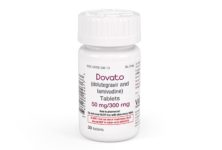Strategies to reduce new HIV infections span multifaceted efforts, including safe-sex counseling, voluntary medical male circumcision, treatment as prevention, and pre- (PrEP) and postexposure prophylaxis. PrEP entails the use of antiretroviral (ARV) drugs prophylactically by HIV-negative individuals at risk of infection to thwart acquisition of the virus.
In 2012, the US Food and Drug Administration (FDA) approved Truvada, a daily oral pill for PrEP comprising 2 reverse transcriptase inhibitors, tenofovir disoproxil fumarate (TDF) and emtricitabine (FTC). This landmark approval was followed by approval from several other countries in North America and South America, Europe, and Africa. Support for oral PrEP emerged through pivotal randomized controlled trials investigating Truvada in men who have sex with men (MSM), serodiscordant heterosexual couples in Kenya and Uganda, heterosexual men and women in Botswana, and users of injection drugs in Thailand. The 2015 guidelines from the World Health Organization recommend oral PrEP for all populations at significant risk of HIV infection.
One approach doesn`t fit all
Clinical findings for oral PrEP in healthy participants demonstrated efficacy but also illuminated the importance of user adherence for protection. For example, the first randomized controlled trial for PrEP (iPrEx, daily oral TDF and FTC in MSM) showed a 44% reduction in HIV acquisition but protection as high as 92% in the subset of individuals with detectable levels of tenofovir in the plasma. Importantly, oral PrEP is particularly unforgiving for women, with over 5 doses per week required to confer protection from vaginal exposure. As the FEM-PrEP and the VOICE clinical trials underscored, inconsistent use (or low adherence) of daily oral and vaginal ARV-based prevention products among the participating women resulted in no protection against HIV. Research about product preference in hypothetical settings or with actual products has shown that no single product is appealing across different groups of women and that a diversification of drug delivery forms is needed to optimize prevention coverage. Because PrEP is an elective tactic for HIV prevention, the ability of an individual to select a product that suits his or her lifestyle from an array of options may enhance the likelihood of adherence.
Efforts to develop alternative PrEP delivery systems have leveraged existing technologies, particularly with the plethora of products available for contraception. Strategies for PrEP include approved oral pills and topical delivery forms, such as vaginal rings, that are currently in the regulatory approval process. Long-acting injectables, comprising the nanosuspension formulation of cabotegravir that requires dosing every 2 months, are in phase 3 clinical trials for HIV-uninfected women, MSM, and transgender women. Implants for HIV PrEP are in preclinical and early clinical studies, with a first-in-human trial planned to evaluate a subdermal implant containing tenofovir alafenamide (TAF) in South African women.
The PrEPP implant: General features
Long-acting implants for PrEP are currently under development and mimic many aspects of contraceptive implants currently on the market (eg, Nexplanon and Jadelle). The PrEP implants are designed for placement under the skin, where the device resides and releases the ARV drug at a controlled rate over time. A subdermal implant can assist individuals seeking discretion when stigmatized for accessing oral PrEP or when unable to negotiate safe sex—a challenge of particular salience to young women and girls in high-incidence regions. Similar to long-acting injectable nanosuspensions, the long-acting delivery of ARV drugs from an implant supports user independence by eliminating the need for adherence to regimens of daily pills or on-demand products. However, unlike long-acting injectables, implants are retrievable throughout the duration of drug delivery, a critical feature in cases of adverse reaction or desire for discontinuation. Additionally, implants offer an improved, sustained pharmacokinetic profile compared with pills. Subdermal delivery of an HIV PrEP implant will likely use a trocar approach similar to that of contraceptive implants, which may require local capacity building and training for providers to support product implementation.
Current development of hiv PrEP implants
Research is still underway to fully develop this drug delivery system. Several research groups, funded through government sources (eg, the United States Agency for International Development and the National Institutes of Health) and private sources (eg, the Bill and Melinda Gates Foundation), are advancing distinct implant designs with a combination of different configurations, classes of ARV drugs, and product profiles. RTI International, a nonprofit research institute, in collaboration with academic partners, is developing a long-acting implant with zero-order delivery kinetics that can be inserted with existing contraceptive trocars. The implant, which comprises the FDA-approved polycaprolactone material, is biodegradable but otherwise remains retrievable during the drug delivery phase (see Feature image). It is currently in preclinical studies and has demonstrated sustained release of the ARV drug up to 3 months in the rabbit animal model. RTI International’s biodegradable implant is a versatile platform design applicable for alternative indications, such as the release of hormone contraceptives and as a multipurpose prevention technology (MPT). The Oak Crest Institute of Science is developing a matchstick-sized silicone device that houses TAF. Release of TAF through orthogonal channels coated with polyvinyl alcohol enabled sustained zero-order kinetics of TAF from in vitro assays and safety and pharmacokinetics in beagles over 35 days. Northwestern University is also leading a program to develop implantable PrEP systems, including a reservoir-style implant to deliver TAF and/or cabotegravir.
Also ongoing is the development of nonpolymeric implants, such as a refillable silicon-based nanochannel device at Houston Methodist that contains TAF and FTC. Results of preclinical studies of the refillable implant in rhesus macaques showed sustained levels of tenofovir diphosphate in peripheral blood mononuclear cells (PBMCs) over 83 days and FTC-triphosphate levels in PBMCs for 28 days. Intarcia Therapeutics, a company based in Boston, Massachusetts, is presently expanding the utility of its osmotic pump implant for patients with diabetes to include a new implant for PrEP.
Outlook for PrEP implants
The pursuit of effective implants that are acceptable by users and providers, especially in resource constraint settings, is currently underway. It is part of an expanding prevention toolbox aimed at providing “lifestyle-compatible” options for HIV PrEP. The developmental phase for the implant must remain technically nimble to accommodate new ARVs in the pipeline while also meeting requirements for efficacious dosing and desired durations. Although investigators are leveraging innovations from other market-available implants, delivery of ARV drugs requires new considerations, particularly when designing long-term drug release at doses that are likely an order of magnitude higher than for other indications (eg, hormonal contraceptives). Moreover, critical questions must be addressed for the implant, including safety and the efficacious dosing of ARV drugs from the subdermal space, user acceptability and social adoption, and implementation and roll-out strategies for targeted populations. Despite these critical questions, the promise of an effective and well-tolerated long-acting reversible PrEP system stands. The ability to combine multiple drugs within a single implant is also being evaluated for MPTs and could also hold utility for treatment indications such as antiretroviral therapy. Ideally, the future of HIV PrEP will entail widespread availability of different products to afford individuals the choice to protect themselves against HIV in a manner conducive to lifestyle, circumstances, and perceived risk factors. Continued advancements in drug delivery systems and potent ARVs, combined with effective implementation strategies to provide access to those at risk, instill the promise of hope to combat this epidemic.


 ПОИСК ПО САЙТУ
ПОИСК ПО САЙТУ  поиск по ресурсному центру
поиск по ресурсному центру 



